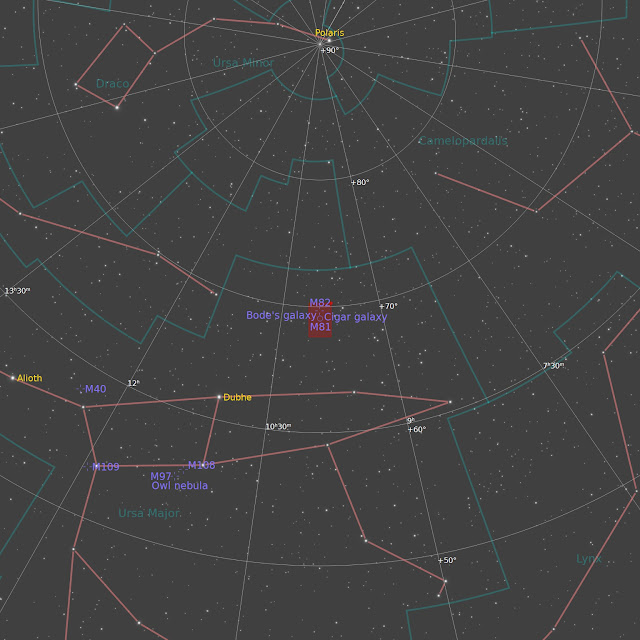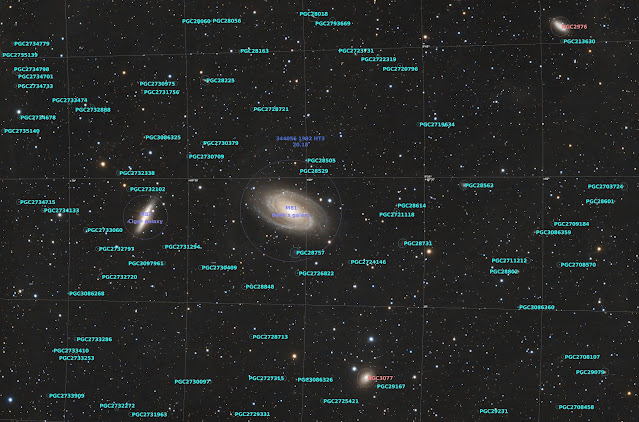What led me down the Rabbit Hole?
Ok, I went down a rabbit hole on trying to identify and understand the distances to background galaxies in a recent image of the M81 & M82. I have a strong interest in finding a background galaxy that is about 380 million light years distant from Earth. Why? Well, one of the places I'm active in doing Astronomy outreach is Penn Dixie Fossil Park & Nature Reserve. The fossils found at there are about 380 million years ago. Scott Roberts from Explore Scientific calls astronomers "Hunters of Fossil Light". I find this sentiment particularly inspiring, especially due to my ties with Penn Dixie. This is what's behind my goal of finding a galaxy 380 million years away. I want to find fossil light that matches the fossils at Penn Dixie.
I recently acquired a new camera for astrophotography, a ZWO ASI2600MC Pro dedicated astronomy camera. In late February there was a rare and brief window of clear skies. Perfect for experimenting with the new camera on my imaging rig. I captured just under two hours worth of exposures on M81 & M82. The resulting image came out ok. Definitely could benefit from more time on this target.
 |
| Processed image of M81 & M82 from 2/25/2023 |
 |
| Where to find M81 & M82 in the night sky. |
Annotating the image in PixInsight
After processing the image in PixInsight, I plate solved the image. What is plate solving? Specialized software compares the stars in the image to a database and precisely locates the image in the night sky. This enables identification of objects contained within the field of view of the image. I used PixInsight's image annotation script to identify and display objects captured in the now solved image. I was blown away by the result.
 |
| Annotated image of M81 & M82. Look at all of the galaxies! |
Identifying the objects in the image
If you Zoom in, there is something there for almost every object identified. That something can be a smudge, a faint spot or a tiny streak. Experimenting with the annotation script, I discovered the result could output to a text file. This text file was imported into Excel and I began the process of trying to identify the light travel time for the objects identified in the image. Using Jason Guenzel's article "How To Identify Objects in Your Astrophotos" from the May 2022 issue of Astronomy Magazine as a guide, The Sinbad Astronomical Database and The NASA/IPAC Extragalactic Database (NED) were used to identify the light travel time to most of the objects identified in the annotated image.
 |
| Object List from the annotated image of M81 & M82 |
In the table above, the designation of "M' indicates the object is the Messier catalog, 'NGC" New General Catalog, "PGC" Principle Galaxies Catalog, & "ARP" Arp's Atlas of Peculiar Galaxies. The distances from Earth to the main objects in the list are given in Megaparsecs (Mpc) and Million light-years (Mly), as they were easily found in Wikipedia. For the remainder of the objects, the light travel time is given in Gigayears (Gyr) form SINBAD and NED. One Gigayear is one billion light years. For example, in the table above, the light travel time for the galaxy PGC28018 is 0.215 Gyr or 215 million light-years and for PGC28056 that's 1.506 Gyr or 1.5 billion light-years.
Mind Blown!
In this hobby it's "normal" to throw around unfathomably large numbers. I don't think our limited human experience allows us to fully appreciate the scale of these numbers. Let's look at the difference between one million and one billion as an example. One million seconds is about 10 days and one billion seconds is over 30 years! I don't know about you, but this blows my mind and is a large part of what fascinates me about this hobby.
I hope you enjoyed my trip down this rabbit hole.
Clear Skies!
Ernie




No comments:
Post a Comment